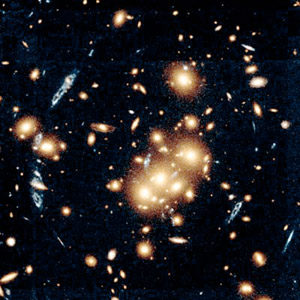Dikla Oren

https://www.hayadan.org.il/gravlens.html
Many examples are known of cases where a galaxy acts as a gravitational lens and produces several images of a distant object, such as a bright quasar hiding behind it. However, one mystery has remained for twenty years: Einstein's theory of general relativity predicts that an odd number of images should form, but almost all observed cases of gravitational lensing have shown only two or four images.
Now, astronomers Joshua Winn of the Harvard-Smithsonian Center for Astrophysics (CfA) and two of his former colleagues from the institute, David Rosin (now at the University of Pennsylvania) and Christopher Kochanek (of Ohio State University), have identified a third central image of a quasar, which is gravitationally lensed.
Radio observations of the system, known as PMN J1632-0033 located in the constellation Ophiuchus, revealed a faint central image. The central image can be used to study the properties of the galaxy, which causes the gravitational lens, and the properties of the massive black hole, which is estimated to reside at its center.
"Finding the central image is an interesting matter in itself, but even more important is the information that the image will provide us about the galaxy causing the clouding. This is a new tool for studying galaxies so far away that even the Hubble Space Telescope sees them as dim specks," Wynn said.
Quasars are very distant, bright objects that are believed to be powered by supermassive black holes. They radiate strongly, because they convert the gravitational energy of matter, which falls into the black hole, into visible light and other types of radiation such as radio waves.
In gravitational lensing, the light rays from a quasar, which pass near the galaxy, are bent by the galaxy's gravitational field, similar to the way light rays are bent as they pass through a glass lens. As the density of the center of the galaxy increases and its gravitational field increases, the central image will be dimmer. However, the central image, whose light passed closest to the center of the galaxy used as a lens, can tell us a lot about the heart of the galaxy. This possibility makes finding the central images a particularly desirable thing.
In the system PMN J1632-0033 an elliptical galaxy, whose redshift is z 1 (its distance from us is about eight billion years), causes the bending of the light of a quasar, whose redshift is z = 3.42 (its distance from us is about 11.5 billion years). They have known for a long time about the existence of two images of the quasar, and suspected that a third, very faint radio source is the central image. However, the third image was found just above the galaxy causing the gravitational lens, so it is possible that the image was part of the galaxy itself.
The "radio color" or spectrum of the three images was examined with the help of the "Very Large Array" and the
"Very Long Baseline Array" of the National Science Foundation. With the help of the spectrum, Wynn and his colleagues presented extremely convincing evidence that the third radio source is indeed the central image of the quasar. Its spectrum is essentially the same as the other two images, except for the low frequencies, where some of its radio energy has been absorbed by the lensing galaxy.
The geometry and properties of the three images of the quasar already provide us with information about the galactic core that causes the gravitational lens. For example, the mass of the black hole at the center of the galaxy is less than two hundred million solar masses. Also, the surface density (the amount of matter relative to the part of the sky) in the area in the center of the central image exceeds 20,000 solar masses per square fraction (the surface density of the Milky Way in our solar region, on the other hand, is 50 solar masses per square fraction). Both observations of the lensing galaxy are consistent with the predictions, which are based on meticulous observations of galaxies much closer to Earth.
"Almost all of our knowledge of galactic centers is derived from the study of very nearby galaxies. "What is amazing about the discovery of a central crypt is that it can give us similar information about the cores of galaxies that are hundreds of times more distant from us and billions of years younger than our neighboring galaxies," Wynn said.
The Harvard-Smithsonian Center for Astrophysics, located in Cambridge, Massachusetts, is a collaboration between the Smithsonian Astrophysical Observatory and the Harvard College Observatory. CfA scientists, divided into six research departments, study the origin, evolution and fate of the universe.
Dikla Oren translated this article - from a press release of the Harvard Smithsonian Center.
